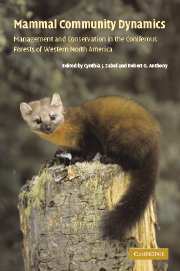 Mammal Community Dynamics
Mammal Community Dynamics Book contents
- Frontmatter
- Contents
- List of contributors
- Foreword
- Acknowledgments
- Part I Management and conservation issues for various taxa
- 1 Introduction and historical perspective
- 2 Forests and woodlands of western North America
- 3 Faunal composition and distribution of mammals in western coniferous forests
- 4 Habitat ecology and conservation of bats in western coniferous forests
- 5 Ecological relationships of terrestrial small mammals in western coniferous forests
- 6 Ecology and conservation of arboreal rodents of western coniferous forests
- 7 Small and mid-sized carnivores
- 8 Ecology, conservation, and restoration of large carnivores in western North America
- 9 Ungulates in western coniferous forests: habitat relationships, population dynamics, and ecosystem processes
- Part II Community and ecosystem relations
- Part III Conservation issues and strategies
- Index
- References
6 - Ecology and conservation of arboreal rodents of western coniferous forests
Published online by Cambridge University Press: 15 December 2009
- Frontmatter
- Contents
- List of contributors
- Foreword
- Acknowledgments
- Part I Management and conservation issues for various taxa
- 1 Introduction and historical perspective
- 2 Forests and woodlands of western North America
- 3 Faunal composition and distribution of mammals in western coniferous forests
- 4 Habitat ecology and conservation of bats in western coniferous forests
- 5 Ecological relationships of terrestrial small mammals in western coniferous forests
- 6 Ecology and conservation of arboreal rodents of western coniferous forests
- 7 Small and mid-sized carnivores
- 8 Ecology, conservation, and restoration of large carnivores in western North America
- 9 Ungulates in western coniferous forests: habitat relationships, population dynamics, and ecosystem processes
- Part II Community and ecosystem relations
- Part III Conservation issues and strategies
- Index
- References
Summary
Introduction
Arboreal rodents were selected as a focal group because of their obvious association with forest canopies and relevance to forest management. The close association of arboreal rodents with trees predisposes them to being impacted by timber harvests (Carey 1989, Aubry et al. 2003, Hallett et al. 2003). Trees provide food, thermal and escape cover, shade, moisture and free water, and cavities that provide nest sites and safe refugia from avian and mammalian predators (Carey 1989, Carey et al. 1999, Aubry 2003). Carey (1989) characterized arboreal rodents according to their degree of dependence on trees for various activities and identified the following stand elements as important to their biology: large live trees, large snags, fallen trees, woody debris, multilayered canopy, overstory and understory diversity, and epiphytes. Additionally, he listed stand stability and landscape contiguity as important attributes with dense underbrush, streamsides, rock, and talus as special features (Carey 1989). More recent studies (e.g., Rosenberg and Anthony 1992, Waters and Zabel 1995, Smith and Nichols 2003) provide new information to examine the conclusions of Carey (1989), which serve as useful hypotheses regarding influences of forest management on arboreal rodent populations in western coniferous forests.
We selected species that are reputed late-seral forest habitat specialists or are known to be important prey for the northern spotted owl (Forsman et al. 2001, Hamer et al. 2001), the American marten (Buskirk and Ruggiero 1994, Ben-David et al. 1997), or the northern goshawk (Accipiter gentilis, Lewis 2001).
- Type
- Chapter
- Information
- Mammal Community DynamicsManagement and Conservation in the Coniferous Forests of Western North America, pp. 157 - 206Publisher: Cambridge University PressPrint publication year: 2003
References
- 18
- Cited by


